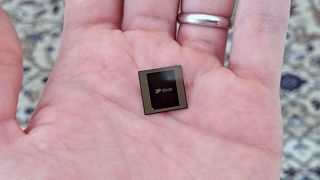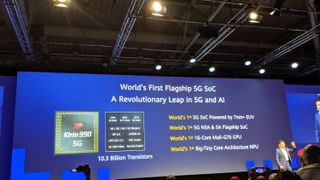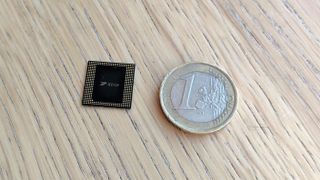Huawei’s 7nm Kirin 990 Is its First 5G SOC

Huawei today announced its Kirin 990 5G system on a chip, which it calls the “world’s first flagship 5G SOC.” It made the announcement here in Berlin at its IFA keynote.
The SOC is produced on a 7nm FF+ EUV process and has 10.3 billion transistors on board. Huaweiclaims to have a board area 36 percent smaller than its competitors, Samsung and Qualcomm.
| Row 0 - Cell 0 | Kirin 990 5G | Kirin 990 |
| Process | 7nm+ EUC | 7nm |
| CPU | 2x Cortex-A76 @2.86GHz2x Cortex A76 @2.36GHz4x Cortex-A55 @1.95GHz | 2x Cortex-A76 @2.86GHz2x Cortex A76 @2.09GHz4x Cortex-A55 @1.86GHz |
| GPU | 16-core Mali-G76 | 16-core Mali-G76 |
| NPU | 2 Big Core + 1 Tiny Core | 1 Big Core + 1 Tiny Core |
| UFS | UFS 3.0, UFS 2.1 | UFS 3.0, UFS 2.1 |
| Modem | 2G/3G/4G/5G | 2G/3G/4G |
This will compete with the Samsung Exynos 980, which that company announced on Wednesday in a surprise drop. That chips is aimed at the mid-range, however, while Huawei is considering the Kirin 990 5G a flagship chip. Huawei is also announcing the Kirin 990, a slightly less powerful chip without 5G support.

Huawei suggests that the chip and receivers will use machine learning to ensure high data speeds. When you enter a weak 5G signal area, the modem will split uplink between 4G and 5G. Kirin 9905G will support both 5G non-standalone (NSA) and 5G standalone (SA) networks.
It claims that the chip will offer a downlink up to 2.3Gbps and uplink of up to 1.25Gbps. The chip supports four sub-6 antennae.

As for the image signal processor (ISP), Huawei is using its fifth-generation dual ISP, and it is claiming improvement in throughput, power efficiency, image and video noise reduction. It also uses block-matching and 3D filtering (BM3D) for what it says will result in DSLR-style noise reduction on its phones.
The GPU on the Kirin 990 5G is the 16-core Mali-G76; that’s up from 10 cores on the Kirin 980. Huawei claims that a smart cache will help with gaming, reducing GPU-to-memory bandwidth needs by 15% and reducing DDR power consumption by 12%.
Stay on the Cutting Edge
Join the experts who read Tom's Hardware for the inside track on enthusiast PC tech news — and have for over 25 years. We'll send breaking news and in-depth reviews of CPUs, GPUs, AI, maker hardware and more straight to your inbox.
The neural processing unit uses Huawei’s Da Vinci architecture and a new “Tiny Core” in combination, which Huawei claims makes it much more efficient. It said that 90% of CV neural networks are supported.
We haven’t yet heard when these new Kirin will be released, or which of Huawei’s devices they’ll wind up in. CEO Richard Yu suggested on stage there will be more news at the launch event for the Huawei Mate 30 Series in Munich later this month. There’s also the question of course, of whether or not you’ll actually be able to buy any of Huawei’s phones or tablets in the US once they actually arrive with these new SoCs.
Andrew E. Freedman is a senior editor at Tom's Hardware focusing on laptops, desktops and gaming. He also keeps up with the latest news. A lover of all things gaming and tech, his previous work has shown up in Tom's Guide, Laptop Mag, Kotaku, PCMag and Complex, among others. Follow him on Threads @FreedmanAE and Mastodon @FreedmanAE.mastodon.social.
-
AnimeMania Just make it incompatible with the American version of 5G. If you can't win, cheat.Reply -
jimmysmitty Wait so Samsung announces a SoC with 5G then Huawei announces the worlds first? After Samsung announced theirs? Not sure how that works but normally the first to announce it should be the worlds first but then again Huawei is a bit crazy.Reply
Most Popular





